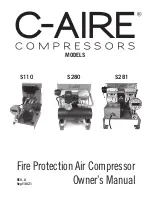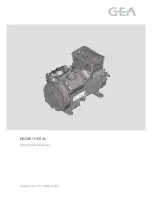
SECTION 1
7
C.
Wear snug-fitting clothing and confine long hair
when working around this compressor, especially
when exposed to hot or moving parts.
D.
Keep access doors, if any, closed except when
making repairs or adjustments.
E.
Make sure all personnel are out of and/or clear of
the compressor prior to attempting to start or
operate it.
F.
Disconnect and lock out all power at source and
verify at the compressor that all circuits are de-
energized to minimize the possibility of acciden-
tal start-up, or operation, prior to attempting
repairs or adjustments. This is especially impor-
tant when compressors are remotely controlled.
G.
Keep hands, feet, floors, controls and walking
surfaces clean and free of fluid, water or other
liquids to minimize the possibility of slips and
falls.
1.6
HOT SURFACES, SHARP
EDGES AND SHARP
CORNERS
A.
Avoid bodily contact with hot fluid, hot coolant,
hot surfaces and sharp edges and corners.
B.
Keep all parts of the body away from all points of
air discharge.
C.
Wear personal protective equipment including
gloves and head covering when working in, on or
around the compressor.
D.
Keep a first aid kit handy. Seek medical assis-
tance promptly in case of injury.
DO NOT
ignore
small cuts and burns as they may lead to infec-
tion
1.7
TOXIC AND IRRITATING
SUBSTANCES
A. DO NOT
use air from this compressor for respi-
ration (breathing) except in full compliance with
OSHA Standards 29 CFR 1910 and/or any appli-
cable Federal, State or Local codes or regula-
tions.
B. DO NOT
use air line anti-icer systems in air lines
supplying respirators or other breathing air utili-
zation equipment and
DO NOT
discharge air
from these systems into unventilated or other
confined areas.
C.
Operate the compressor only in open or ade-
quately ventilated areas.
D.
Locate the compressor or provide a remote inlet
so that it is not likely to ingest exhaust fumes or
other toxic, noxious or corrosive fumes or sub-
stances.
E.
Coolants and lubricants used in this compressor
are typical of the industry. Care should be taken
to avoid accidental ingestion and/or skin contact.
In the event of ingestion, seek medical treatment
promptly. Wash with soap and water in the event
of skin contact. Consult Material Safety Data
Sheet for information pertaining to fluid of fill.
F.
Wear goggles or a full face shield when adding
antifreeze compound to air line anti-icer systems.
G.
If air line anti-icer system antifreeze compound
enters the eyes or if fumes irritate the eyes, they
should be washed with large quantities of clean
water for fifteen minutes. A physician, preferably
an eye specialist, should be contacted immedi-
ately.
H. DO NOT
store air line anti-icer system antifreeze
compound in confined areas.
I.
The antifreeze compound used in air line anti-
freeze systems contains methanol and is toxic,
harmful or fatal if swallowed. Avoid contact with
the skin or eyes and avoid breathing the fumes. If
DANGER
Death or serious injury can result from
inhaling compressed air without using
proper safety equipment. See OSHA stan-
dards and/or any applicable Federal, State,
and Local codes, standards and regulations
on safety equipment.
Summary of Contents for TS20C
Page 10: ...NOTES 10...
Page 13: ...SECTION 2 TS20C USER MANUAL 13 Figure 2 2 Sullair Rotary Screw Air Compressor Air Cooled 200HP...
Page 14: ...TS20C USER MANUAL SECTION 2 14 Figure 2 3 Sullair Rotary Screw Air Compressor Air Cooled 250HP...
Page 23: ...NOTES 23...
Page 64: ...TS20C USER MANUAL SECTION 2 64 Figure 2 22 TS20C SSRV NC SUPV AC WC 02250178 822 R02...
Page 66: ...TS20C USER MANUAL SECTION 2 66 Figure 2 23 TS20C CUST STR SUPV AC WC 02250178 823 R02...
Page 68: ...TS20C USER MANUAL SECTION 2 68 Figure 2 24 TS20C MFV NC SUPV AC RC 02250178 824 R02...
Page 70: ...TS20C USER MANUAL SECTION 2 70 Figure 2 25 TS20C MFV NC SUPV AC VSD FAN 02250178 825 R02...
Page 72: ...NOTES 72...
Page 76: ...SECTION 3 TS20C USER MANUAL 76 Figure 3 2 Identification TS20C Typical 02250175 122 R03...
Page 78: ...TS20C USER MANUAL SECTION 3 78 Figure 3 3 Identification TS2C0 200HP AC 02250175 130 R03...
Page 80: ...TS20C USER MANUAL SECTION 3 80 Figure 3 4 Identification TS20C 250HP AC 02250175 136 R02...
Page 84: ...TS20C USER MANUAL SECTION 3 84 Figure 3 6 Identification TS20C 200HP WCAC SER 02250175 148 R03...
Page 86: ...TS20C USER MANUAL SECTION 3 86 Figure 3 7 Identification V200TS 100 150HP AC 02250182 109 R02...
Page 100: ...NOTES 100...
Page 107: ...SECTION 4 TS20C USER MANUAL 107...
Page 108: ...NOTES 108...
Page 110: ...NOTES 110...
Page 122: ...TS20C USER MANUAL SECTION 7 122...
Page 123: ...NOTES 123...








































